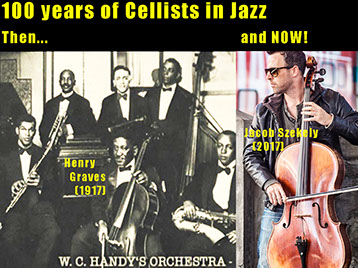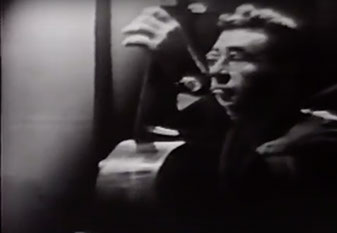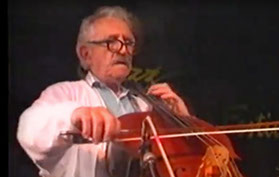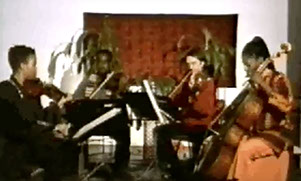CLICK HERE to
SIGN UP for our email list
to get the latest concert information

Point Richmond Jazz has hosted CELLISTS as well as violinist at our monthly concerts. Among the world’s leading exponents of the cello in jazz we've presented are Mark Summer who played for 30 years with the Turtle Island Quartet, Jacob Szekely and his trio, JS3, and Lewis Patzner. Our concerts take place at 201 Martina St. in Point Richmond. Check http://prjazz.org to find out details
One of the Bay Area’s most recognizable commercial ad lines in the 50’s and 60’s was for ‘Berkeley Farms’ milk: “Farms??? In Berkeley???” rang out the incredulous voice of Mel Blanc (voice of Bugs Bunny and Porky Pig) in the ubiquitous radio ad...
Well I imagine you, dear readers, querying in unison in the same tone of voice: “Cellos??? In Jazz???” But YES! While their numbers are even fewer than jazz violinists, cellists HAVE added their unique, rich voice to jazz from it’s earliest days. Often the cello might be used as a replacement for the bass, especially by young players. The great jazz violinist, Claude ‘Fiddler’ Williams, reminisced about using a cello tuned in 4ths (like a standard bass - up an octave, one assumes), as a bass in his brother-in-law’s band in the early 1920’s, when he was too young to wield an upright bass.


In the early 50’s drummer Chico Hamilton founded his Quintet featuring Fred Katz, a former symphony player and student of the classical teacher Pablo Casals, on cello. In the late 50’s he made several jazz albums in his own name including “Zen: The Music of Fred Katz,” “Katz & His Jammers,” and “Soul-o Cello."
Also a pianist and composer, Katz may well be the first jazz cellist to really play solos using the bow and taking an equal part in a jazz ensemble - Chico Hamilton’s Quintet to be specific. Their sound had much to do with making ‘chamber jazz’ a ‘thing.’ But you will remember, Harry Graves did use the bow on W. C. Handy’s ’Snaky Blues’ 30 years earlier in 1917!
The early jazz and blues great W. C. Handy featured a wonderful cellist who, on occasion took solos, Henry Graves, notably on their huge hit, “Snaky Blues.” Handy also at times used his composer/arranger William Grant Still on cello. Still had aspirations to be a classical composer and eventually left the jazz world and went on to be regarded as "the Dean of African-American composers."
But most cellists in early jazz were also bassists, who by in large used the cello in a bass’s role. By the late 40’s the cello was nevertheless at the center of at least one jazz group: Harry Babasin and the Jazz Pickers. Babasin is often credited as the first jazz soloist in Modern Jazz.
But better known from the same period is Oscar Pettiford, the great bassist created something of a sensation when he brought a cello onstage as a joke with the Woody Herman big band in 1949. Pettiford was known even as a bassist for his melodic style, and he did take the cello to a whole different level. But like Babasin, he mostly used the plucked, pizzicato technique used by bassists in jazz, and he also tuned the cello like a bass up an octave. Listen to his seminal Cello album “My Little Cello” on YouTube and/or In a "Cello Mood" with ‘The Duke’ - Duke Ellington!

In the ‘Chamber Jazz’ movement, the cello begins to take larger voice in jazz as the string quartet began to be used more frequently in what was also called ‘Third Stream’ jazz. A prime example is the Modern Jazz Quartet recording called ‘Third Stream Music,’ featuring the Beaux Art String Quartet. In this outing the quartet parts are written out and the players are classical musicians, not jazz players. But soon the string players were wanting to create real jazz. Pioneering groups like Akua Dixon’s ‘Quartette Indigo’, founded in 1973 (originally featuring Gayle Dixon & John Blake Jr., violin; Maxine Roach, viola; Akua Dixon, cello-leader, and at one point including violinist Regina Carter, jump-starting her career), The Uptown String Quartet who worked with Max Roach on his “Double Quartet” recordings, and later the Turtle Island String Quartet, featuring Mark Summer on cello, all used the standard classical string quartet instrumentation, 2 violins, viola, and cello to actually improvise with all members taking solos.

In the sixties and beyond, many top tier bassists also worked with cello. Ray Brown issued an album called “Jazz Cello” demonstrating his skill on the instrument. Ron Carter also has recorded with cello, which he studied before taking up the bass. Eugene Friesen is another example of a bassist who now considers himself a cellist. Friesen, professor at Berklee School of Music, recently said of the one of the foremost of the new generation's cellists, Jacob Szekely: "This is the first time I have heard the cello make the case as a leader in modern Jazz.” Indeed the door is now wide open. Young lions like Szekely, Lewis Patzner, Mike Block, Tom Abbs, Eric Friedlander have established the importance of the cello in jazz and improvised music and we can expect te cello to become an ever more important and creative voice in improvised music.
Join in the history of the bowed strings in jazz... Attend Point Richmond Jazz on the 4th Friday of every month from October through May.
MANY THANKS to
OUR Sponsors:
Like us on Facebook!